Protected Under
Antiquities Act 1975
31°35'17.4"N 74°18'55.4"E
![]()
On the UNESCO World Heritage Site List
Antiquities Act 1975
Emperor Shah Jahan consulted astrologers to select an auspicious moment to first sit in the Diwan-e-Aam after its completion
The Best Time to Visit Punjab Province is Year long as it has bearable Cold winters and Hot Summers. However, Summers can get really Hot and precautions are recommended during Daytime visits.

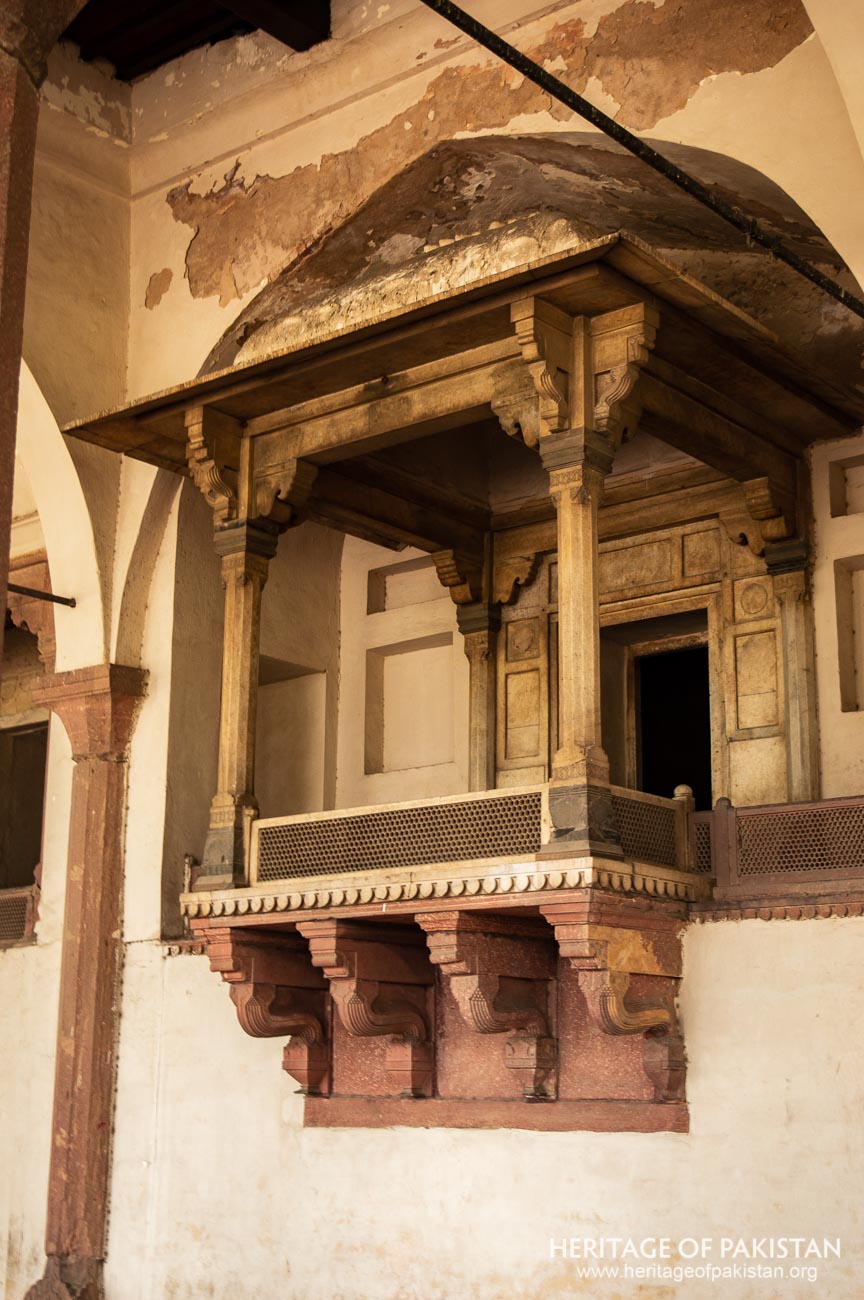
The Diwan-e-Aam, or Hall of Public Audience, is a historically significant structure located within the Lahore Fort. Constructed in 1628 during the first year of Emperor Shah Jahan’s reign, it served as the venue for imperial public gatherings and official ceremonies. The hall is situated in the northern section of the Diwan-e-Aam quadrangle and was erected in front of the Daulat Khana-e-Khas-o-Aam, a structure that dates back to the era of Emperor Akbar.
Shah Jahan initiated the construction of the Diwan-e-Aam simultaneously at both the Lahore and Agra forts. The hall in Lahore Fort was designed as an open pavilion supported by forty pillars, a style referred to as Chihil Sutun (hall of forty columns). This architectural initiative was executed under the supervision of Yamin-ud-Daulah Asif Khan, the emperor’s father-in-law and then Governor of Lahore. At the same time, Asif Khan also oversaw the construction of the Sheesh Mahal, or Shah Burj, located in the north-western section of the fort, considered to be the most exquisite section of the complex.
Contemporary sources provide detailed documentation on the construction and inauguration of the Diwan-e-Aam. Mulla Abdul Hameed Lahori, the court chronicler of Shah Jahan, recorded these details in Badshahnama. Similarly, the account Amal-i-Saleh by Muhammad Saleh Lahori notes that upon the hall's completion, Emperor Shah Jahan, guided by astrologers, entered the newly constructed edifice at an auspicious hour. On that occasion, the poet Talib Kalim recited a Persian ode in the emperor’s presence, praising the structure’s magnificence and comparing its grandeur to the heavens:
"This new edifice in loftiness equals the highest heaven;
Compared with its dignity, eminence itself is but significant.
It is a garden, every pillar of which is like a green cypress tree,
In the shade of which noble and plebian obtain repose."
Functionally, the Diwan-e-Aam served as the primary venue for the emperor’s daily affairs.
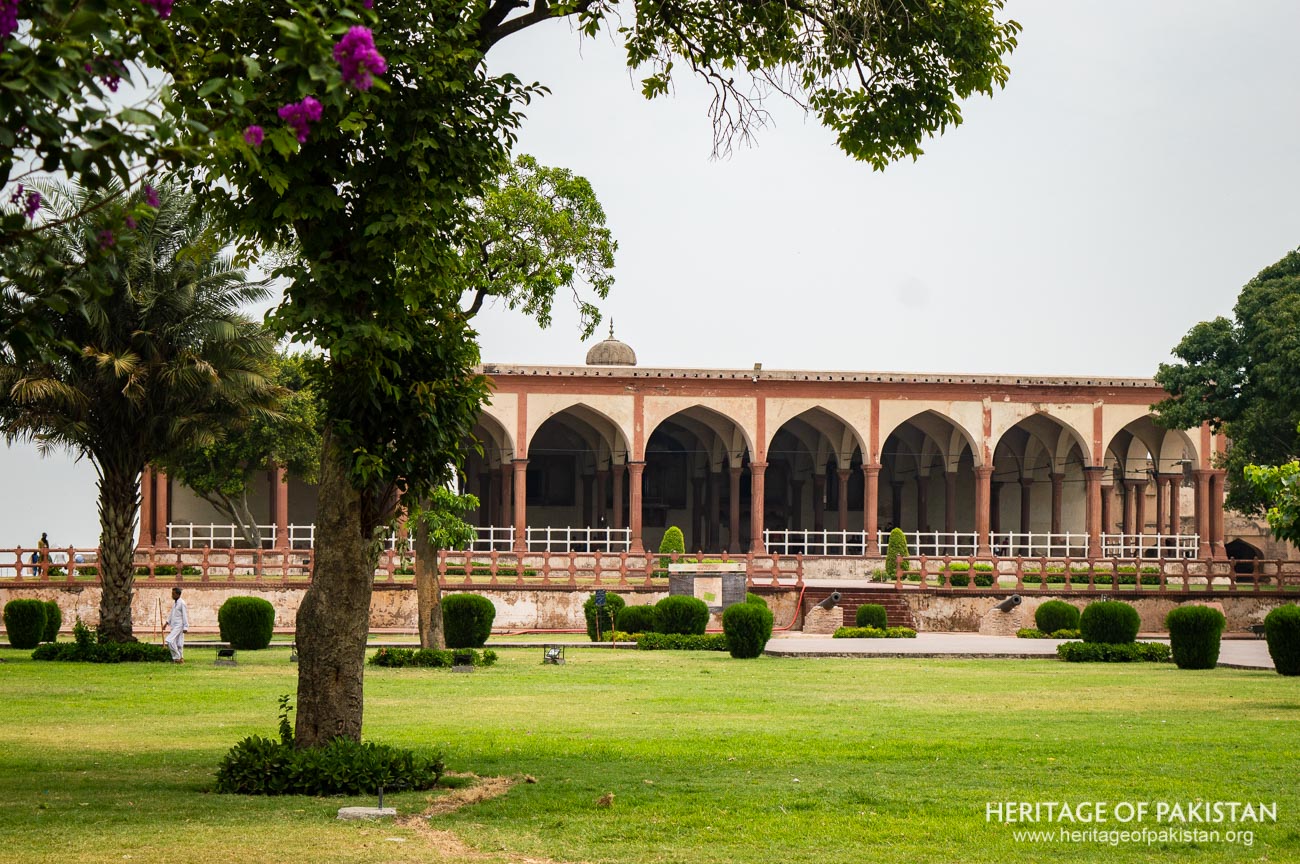
View of Deewan e Aam from Quadrangle, Lahore Fort, Lahore, Punjab
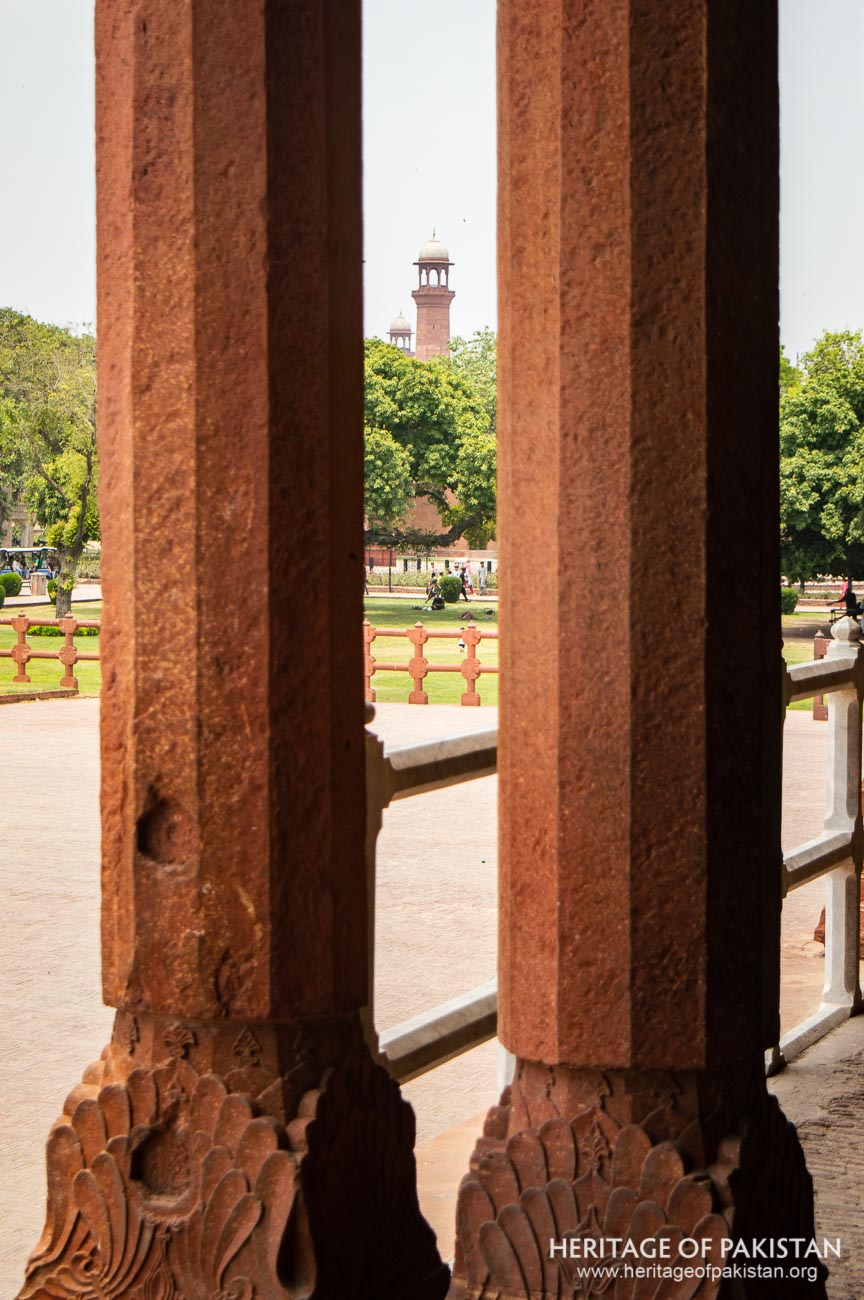
Double Red Sandstone Columns of Deewan e Aam, Lahore Fort
Here, Shah Jahan held court, received members of the public and foreign visitors, and conducted matters of state. A distinctive feature of the hall was the jharoka, or royal balcony, from which the emperor made his daily appearance. As the emperor took his seat, musicians stationed in the Naqar Khana played ceremonial music while attendees filed past in formal review. A religious cleric was also present, occasionally reminding the emperor in a solemn voice of the transience of life. The proceedings often lasted over an hour, during which a considerable amount of administrative work was conducted with diligence.
The structure of the Diwan-e-Aam suffered significant damage during the Sikh War of Succession around 1841. Though Maharaja Ranjit Singh used the hall during his reign, it is noted that he refrained from sitting on the imperial throne out of deference to the Mughal rulers. Following his death, Ranjit Singh’s body was placed temporarily in the Diwan-e-Aam before being taken outside the fort for cremation. The cremation site later became the location of his Samadhi, situated adjacent to Hazuri Bagh.
In the British colonial period, the Diwan-e-Aam underwent substantial alterations. The structure was repurposed as a military barrack and field hospital. The original roof was replaced, and the outer archways were bricked up to enclose the space. These modifications were reversed in the early 20th century as part of restoration efforts aimed at returning the hall to its earlier form. During British rule, the open grounds in front of the Diwan-e-Aam were also used by military personnel as a football ground.
The Diwan-e-Aam remains one of the most architecturally and historically significant elements of Lahore Fort, reflecting both the ceremonial grandeur and administrative functions of Mughal governance.

Arches of Deewan e Aam, Lahore Fort
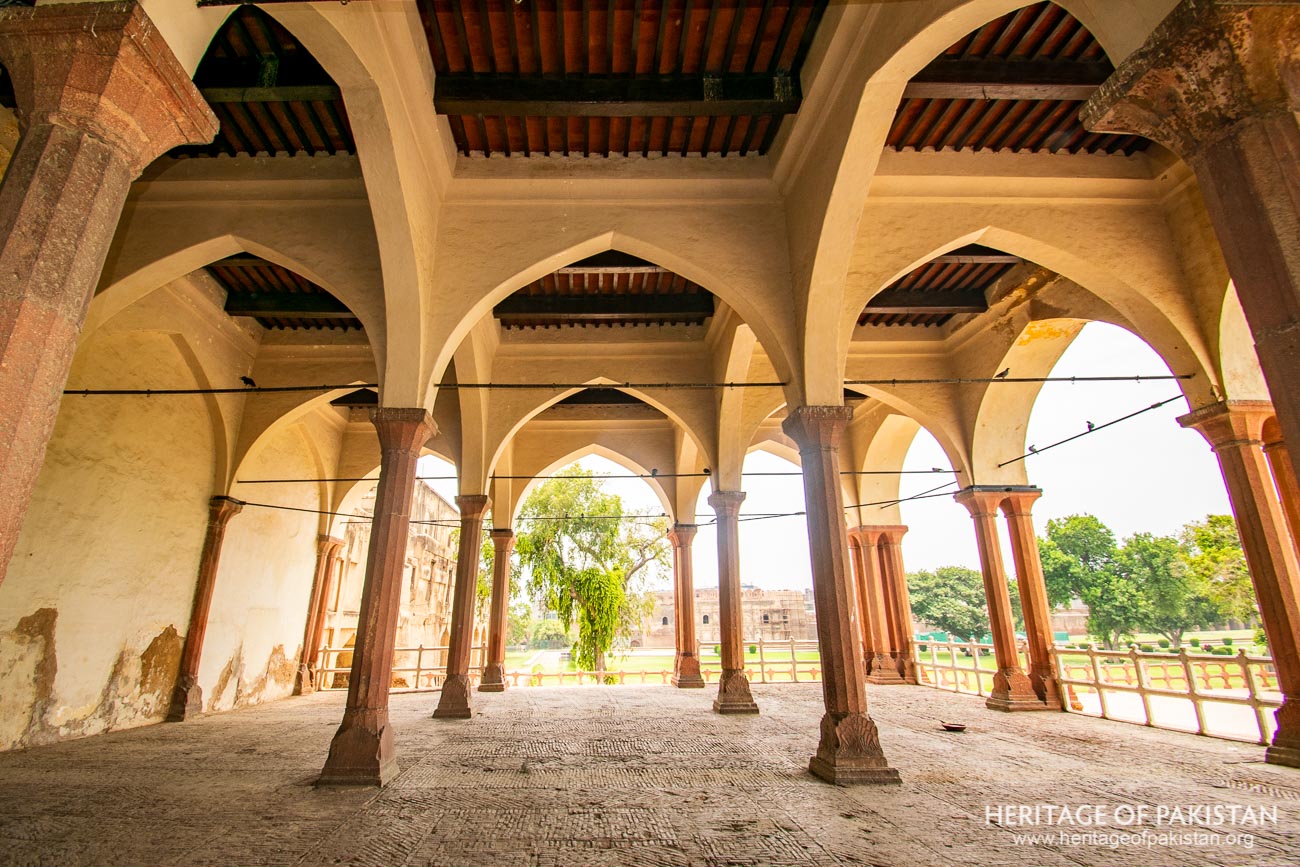
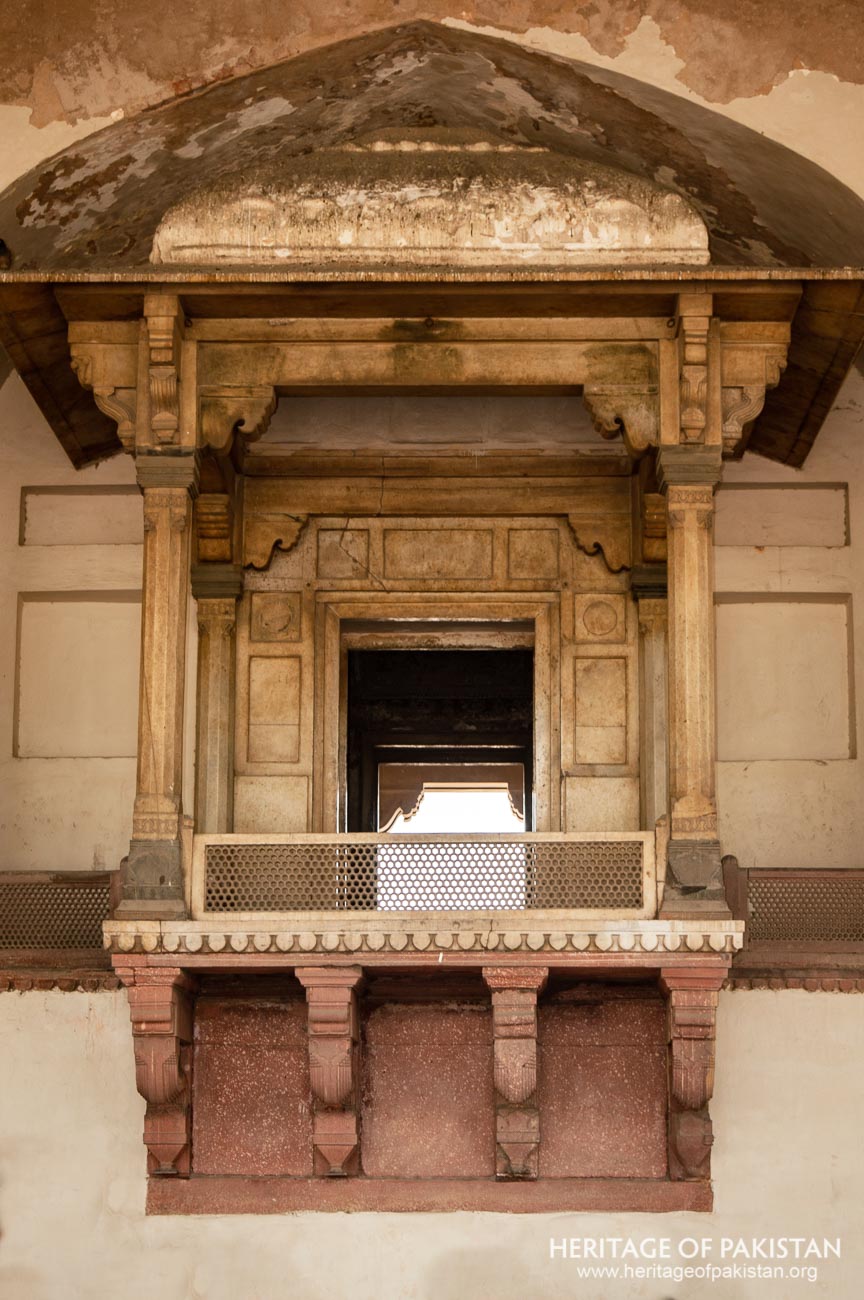
The Royal Balcony or Jharoka
The Diwan-e-Aam is situated in the northern part of its quadrangle within the Lahore Fort. This quadrangle is designed as a large and beautiful garden following the Char Bagh layout, a traditional Persian-style garden divided into four parts. The Diwan-e-Aam directly faces the southern wall of the fort. To its east lies the Masjidi Gate, commonly known today as the Masti Gate, while the Moti Masjid is positioned to its west. On the northern side of the Diwan-e-Aam stands the Daulat Khana-e-Khaas-o-Aam, facing towards what is referred to as Jahangir’s Quadrangle.
The Diwan-e-Aam is a rectangular hall, approximately 178 feet in length and 62 feet in width. It is elevated on a raised platform measuring about 240 feet by 160 feet. The hall is located centrally along the northern side of this platform. Eight steps lead from the platform up to the base of the hall, which itself is further raised. The overall structure rests within the landscaped garden, and steps from the garden lead to the platform. This platform is enclosed by a railing intricately carved and assembled in red sandstone. According to Nazir Ahmed Chaudhry, several historical travellers who wrote about their visits to the Lahore Fort described these railings, noting that they were used to demarcate spaces for different classes of nobles during public gatherings.
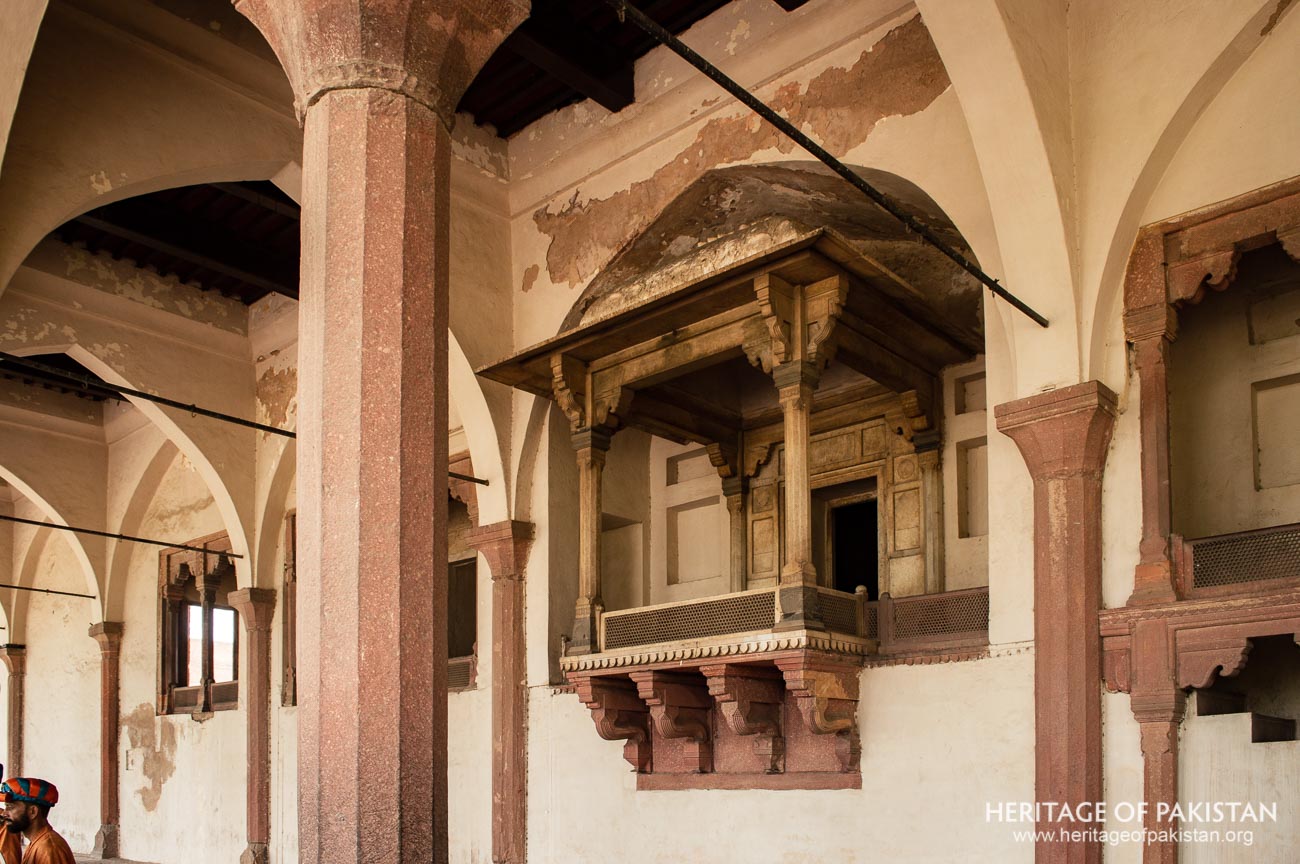
The main hall is an open pavilion supported by forty pillars, hence the architectural style being referred to as Chihil Sutun or “forty columns.” It is open on three sides, with the fourth side dominated by a prominent royal jharoka or balcony, used by the emperor to address the audience. The roof of the Diwan-e-Aam is supported by lofty, pointed arches. On the outer edges of the structure, the arches are held up by double columns, while the interior ones are supported by single columns. The hall contains nine rows of arches along its longer side and three rows on the shorter side.
The royal jharoka is constructed of marble and is supported by four elaborately carved red sandstone brackets. Small marble columns support the main frame of the balcony, while a low marble lattice screen is fixed in front. This jharoka is further flanked by arched window openings embedded in the surrounding red sandstone wall. The back portion of the Diwan-e-Aam, known as the Daulat Khana-e-Khaas-o-Aam, is directly connected to the hall and features the projecting royal balcony.
There are twelve small rooms situated behind the jharoka within the Daulat Khana-e-Khaas-o-Aam. These rooms later became historically significant as the site where Chet Singh was killed in 1839 by Dhian Singh.
Before the construction of the Diwan-e-Aam, during the reigns of Emperors Akbar and Jahangir, courtly gatherings and assemblies took place in the open courtyard, without protection from the sun or rain. The space in front of the Daulat Khana-e-Khaas-o-Aam served this function. To provide shelter for the emperor and assembled nobles, Shah Jahan ordered the construction of the Diwan-e-Aam in front of the existing jharoka, thereby linking his newly constructed audience hall with the older Akbari structure.

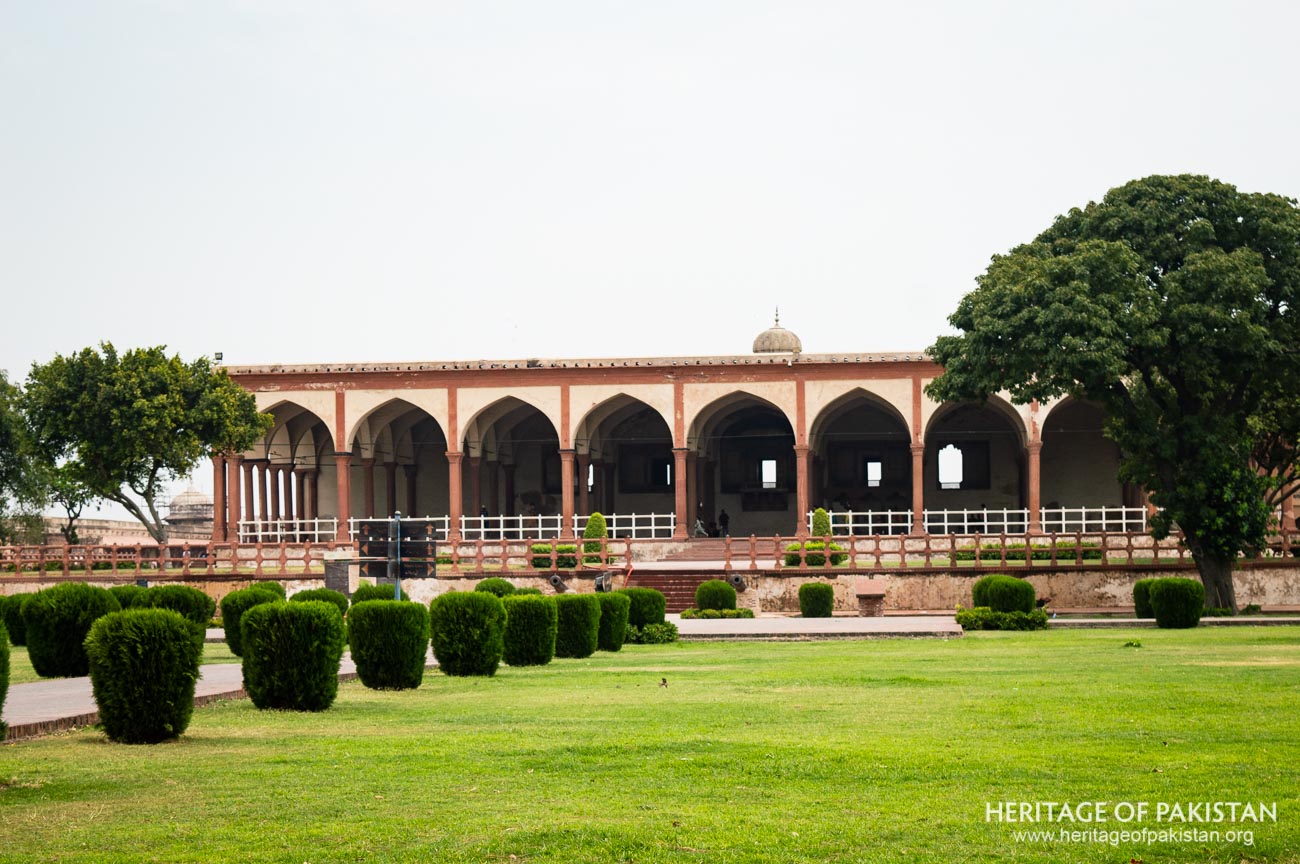

Discover the Deewan e Aam image gallery and immerse yourself in photographs

All Photographs by Syed Noor Hussain and Sania Azhar.
All Rights Reserved. Photos may be used for Non-Commercial, Educational, Artistic, Research, Non-Profit & Academic purposes.
Commercial uses require licensing agreement.


Add a review